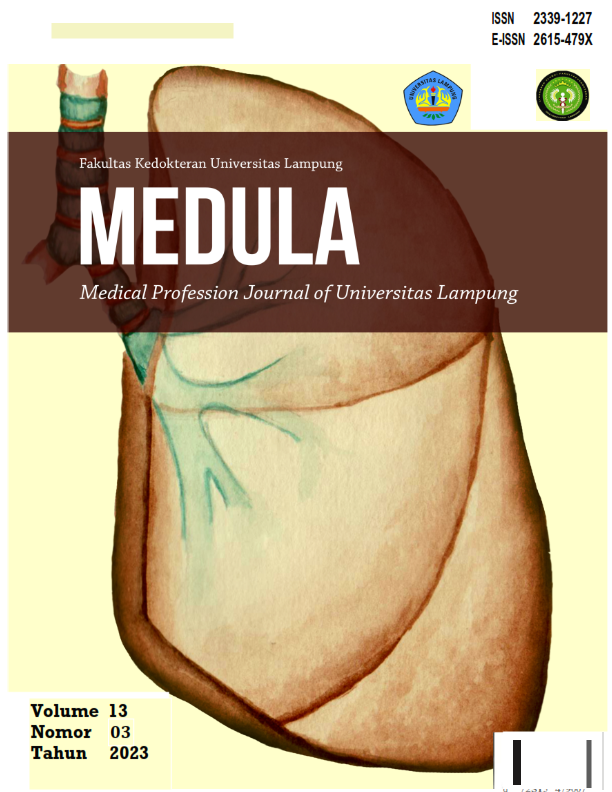Factors That Influence The Incident of Ventilator Associated Pneumonia
DOI:
https://doi.org/10.53089/medula.v13i3.664Keywords:
Nosocomial infection, pneumonia, ventilatorAbstract
Nosocomial infections also reffered to as healthcare-asscociated infections (HAI). This infection can occur both while in the treatment room, during surgical procedurs or actions, and it can also be transmitted through medical devices that have contact with patients such as mechanical ventilators. The use of a mechanical ventilator machine is intended as a life saving measure in critical patients and is usually found in the intensive care unit (ICU) room of a hospital. Ventilator associated pneumonia is a risk that can occur when using a mechanical ventilator machine. VAP is nosocomial pneumonia in patients who have mechanically ventilated with endotracheal tube and tracheostomy for at least 48 hours. In United States, Ventilator Associated Pneumonia is one of the causes of mortality in patients with a mortality rate of 13%. In Europe, mortality rate due to early Ventilator Associated Pneumonia is 19,2% and late Ventilator Associated Pneumonia is 31,4%. Ventilator associated pneumonia is reported to have varying incidence rates ranging from 9-27%. The mortality rate from ventilator associated pneumonia can be more than 50%. This event is influenced by several risk factors, one of which is the duration of using a mechanical ventilator. The use of a mechanical ventilator, especially during the installation of an endotracheal tube (ETT) can damage the defense barrier in the airways, the installation of an ETT can also damage the mucociliary and tracheal epithelium and interfere with the cough reflex. This allows pathogens to invade the lower respiratory tract resulting in ventilator associated pneumonia.
References
Sikora A, Zahra F. Nosocomial Infections. StatPearls Publishing. 2022.
Wu D, Wu C, Zhang S, Zhong Y. Risk Factors of Ventilator-Associated Pneumonia in Critically III Patients. Frontiers in Pharmacology. 2019; 10(482): 1-7.
Nency C, Irawan D, Andrini F. Gambaran Kejadian Ventilator-Associated Pneumonia pada Pasien yang Dirawat di ICU Dan CVCU Rsud Arifin Achmad Periode Januari 2013 S/D Agustus 2014. Jom FK. 2015; 2(2): 1-9.
Rahman D, Huriani E, Julita E. Kejadian Ventilator Associated Pneumonia (VAP) Pada Klien Dengan Ventilasi Mekanik Menggunakan Indikator Clinical Pulmonary Infection Score (CPIS). Jurnal Ners. 2021; 6(2): 126-35.
Susanti E, Utomo W, Dewi YI. Identifikasi Faktor Risiko Kejadian Infeksi Nosokomial Pneumonia pada Pasien yang terpasanga Ventilator di Ruang Intensive Care. Jurnal Online Mahasiswa Unri.2015; 2(1):590-9.
Alfaray RI, Mahfud MI, Faizun RS. Duration Of Ventilation Support Usage And Development of Ventilator-Associated Pneumonia: When Is The Most Time At Risk?. IJAR. 2019; 1(1): 26-31.
Febyan, Lardo S. Patogenesis Ventilator Associated Pneumonia Terkini di Intensive Care Unit. Indonesian Journal Chest. 2018; 5(4): 35-44.
Riatsa A, Nana R, Nur K. Faktor-Faktor yang berhubungan dengan Kejadian Ventilator Associated Pneumonia (VAP) pada Pasien yang menggunakan Ventilator Mekanik di ICU RSUD Tugurejo Semarang. Jurnal NERS Widya Husada. 2017; 4(7) : 1-7.
Jovanovic B, Milan Z, Markovic DL, Djuric O, Radinovic K, Doklestic K et al. Risk Factors for Ventilator-Associated Pneumonia in Patients with Severe Traumatic Brain Injury in a Serbian trauma centre. International Journal of Infectious Diseases. 2015; 38: 46–51.
But A, Yetkin MA, Kanyilmaz D, Aslaner H, Bastug A, Aypak A, et al. Analysis of Epidemiology and Risk Factors for Mortality in Ventilator-Associated Pneumonia Attacks in Intensive Care Unit Patients. Turkish Journal of Medical Sciences. 2017; 47(3): 812–6.
Khayati N, Rohana N, Apriana R. Faktor-Faktor yang berhubungan dengan Kejadian Ventilator Associated Pneumonia. Jurnal NERS Widya Husada. 2017; 4(3):85-94.
Awalin F, Faridah I, Ridwan US. Faktor-Faktor yang berhubungan dengan Ventilation Associated Pneumonia (VAP) pada Populasi Pasien Gangguan Persyarafan di Ruang ICU RSU Provinsi Banten. Jurnal Kesehatan. 2019; 8(2):1-15.
Affanin RN, Victoria AZ, Nuraeni A. Hubungan Lama Penggunaan dan Frekuensi Oral Hygiene Pasien dengan Ventilator Mekanik terhadap Ventilator Associated Pneumonia (VAP ) di Ruang ICU. 2022; 1(1):13-21.
Azis A, Sawitri, Parwati T. Cuci Tangan sebagai Faktor Risiko Kejadian Ventilator Associated Pneumonia di RSUP Sanglah Denpasar. Public Health and Preventive Medicine Archive. 2012; 1(2):120-5.
Saputra RA, Riza S, Desreza N. Hubungan Faktor Predisposisi dengan Kejadian Ventilator Associated Pneumonia (VAP) pada Pasien Post Operasi di Ruang Intensif RSU Meuraxa Kota Banda Aceh. Journal of Healthcare Technology and Medicine. 2022; 8(2):1114-22.
Downloads
Published
How to Cite
Issue
Section
License
Copyright (c) 2023 Medical Profession Journal of Lampung

This work is licensed under a Creative Commons Attribution-ShareAlike 4.0 International License.














